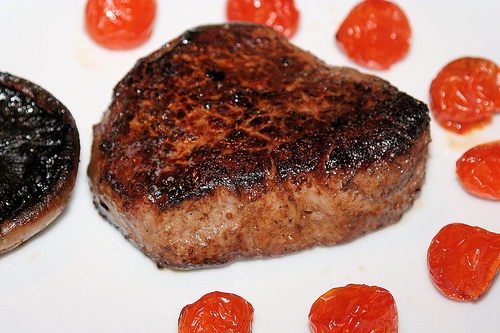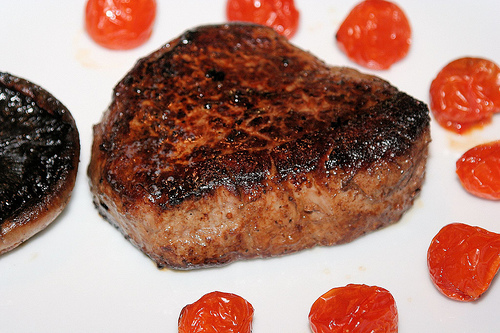In Tom’s Kitchen, Grist’s food editor discusses some of the quick-and-easy things he gets up to in, well, his kitchen.
———-
In my kitchen, beef is a precious ingredient. After years of writing the Meat Wagon column, the only beef I’m interested is of the grass-fed variety–preferably from cows raised on a nearby pasture. In my greater foodshed, two of the best sources are Cane Creek Farm in the Triangle and Hickory Nut Gap outside of Asheville. Both practice multi-species rotational grazing–a highly productive, low-impact form of farming popularized by Joel Salatin of Polyface Farm. In my immediate area, I buy beef from Alan Souther’s Rocking S Farm in Allegheny Country. I urge all beef eaters to seek out nearby pasture-based producers.
 Put a steak to your heart this Valentine’s Day.Neil Vance via FlickrEven when it’s local and pasture-raised, I still use beef sparingly. I’ve come to love the so-called tough (and relatively cheap) cuts–the roasts and shanks and ribs that become tender and delicious with long, slow cooking. But that’s for another day. Valentine’s Day is coming up–a good excuse for a special dinner with a special friend. And that’s got me thinking about tender cuts–i.e. steak. Because of its price and preciousness — and because romantic dinners should be light dinners — I recommend small portions with plenty of vegetables on the side.
Put a steak to your heart this Valentine’s Day.Neil Vance via FlickrEven when it’s local and pasture-raised, I still use beef sparingly. I’ve come to love the so-called tough (and relatively cheap) cuts–the roasts and shanks and ribs that become tender and delicious with long, slow cooking. But that’s for another day. Valentine’s Day is coming up–a good excuse for a special dinner with a special friend. And that’s got me thinking about tender cuts–i.e. steak. Because of its price and preciousness — and because romantic dinners should be light dinners — I recommend small portions with plenty of vegetables on the side.
Steak for two with red wine/Dijon sauce
Mise en place:
• A half-pound chunk of grass-fed ribeye or other tender cut, about an inch thick
• Good sea salt and a loaded pepper grinder
• Some high-quality cooking fat. For searing the steaks, I like to use a combination of top-quality butter (e.g., Organic Valley’s “Pasture Butter”) and organic canola (I always go for organic canola to avoid GMOs). Butter delivers great flavor and helps the steak brown; canola raises the overall “smoke point” of the combined fats, meaning they won’t scorch and smoke as easily. For the best of all worlds, use home-made clarified butter–high smoke point, great flavor. You will be using fat at three stages in the process. For the first two, use any combo of butter and cooking oil. For the third, only butter will do.
• 2-4 cloves garlic, peeled and sliced thin (I use three)
• 1-2 shallots, peeled and sliced thin (I use one)
• About a cup simple, non-oaky red wine (when reduced, the wood flavors in oaked wines take over a sauce–in an unpleasant way).
• A good spoonful of Dijon mustard
• A handful of parsley, chopped
Process:
Pat steaks dry with a kitchen towel (wet steaks won’t brown well); liberally salt and pepper both sides. Add about two tablespoons total fat to a small (just big enough to hold the steak) skillet; turn heat to medium high. (Turn hood exhaust to high; nothing ruins the Valentine’s mood like smoke from a searing steak.) When butter melts and its foam subsides, add the steak. Cook about 3.5 minutes per side for rare; 4.5 for medium-rare. The steaks should be very brown on both sides. Move steaks to a to a plate; turn off heat.
Pour excess fat from the pan and discard. Add another tablespoon of butter (or other oil); turn heat to medium-low. When butter melts and its foam has subsided, add the shallots and garlic. Turn heat to medium. Cook, stirring with a wooden spoon, until garlic/shallots are soft and have begun to color (don’t let them scorch). Add the wine, turn heat to high, and stir, scraping the bottom of the pan to work in any caramelized bits on the bottom of the pan. This is called “deglazing the pan”–one of the most satisfying things a cook can do. Those brown bits on the pan’s bottom are culinary gold; liberating them into the sauce will give it incomparable depth of flavor. Allow to reduce and become syrupy; there should be just about a third of a cup left. Turn heat to low. Stir in the Dijon mustard; then a small knob butter, about a half tablespoon. The butter will add a pretty sheen to the sauce, as well as creaminess. f you’re not using butter, omit this step. You don’t want canola at this stage. Cut the steak in half on a cutting board, and pour any juices that have accumulated on its plate into the pan. Return the bisected steak to the pan,. Let the cutlets reheat for a minute. Correct the sauce for salt; give it a good lashing of pepper and serve, drenching with the steak sauce and topping with parsley. Serve with plenty of roasted potatoes and/or carrots and sauteed kale, collards, or chard.
For wine, a red Cote du Rhone or Spanish Rioja would go great. For something different, try a Dolcetto d’Alba from Italy’s Piedmont region, where they know how to enjoy meat. Here’s a fine example.


